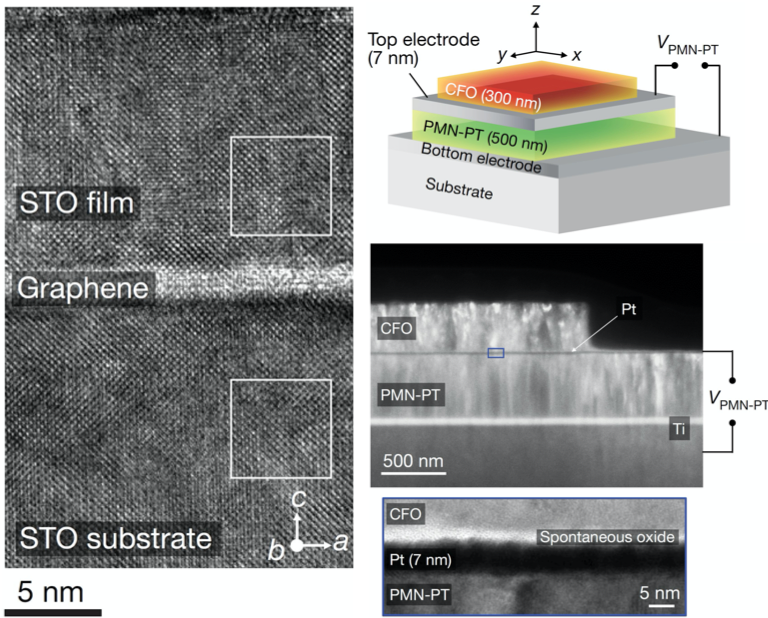Stacking of Oxide Heterstructures
Introduction:
Complex oxides offer a wide range of phenomenal electrical and magnetic properties when prepared as high-quality single crystals, but integrating oxides into stacks to realize new device concepts is severely limited by constrains on structure and chemistry. Through the use of “remote epitaxy”—where graphene separates a growing oxide thin film from its substrate—superb crystallinity is achieved together with the ability to peel off oxide layers and create stacks of multiple high-quality layers assembled in a user-defined sequence. The approach heralds a new platform for the limitless stacking of any material into any heterostructure.
|
Figure: (left) Cross-sectional transmission electron microscopy image of a STO film grown on a graphene coated STO substrate. The crystallinity can be observed for both STO structures. (top-right) Device schematic of a magnetoelectric device that consists of layers of CoFe2O4 and PNM-PT. (bottom right) Cross-sectional TEM image of the CFO/PMN-PT membrane heterostructure. A thin Pt (7 nm) film was deposited before transferring the CFO as the top contact to PMN-PT. A zoom to the interface region of CFO/Pt/PMN–PT shows that an oxide bonding layer has formed spontaneously between CFO and PT |
Previously impossible combinations have been demonstrated that involve the stacking of structurally and chemically incompatible piezoelectrics and magnetostrictive oxides to make new composite multiferroics; oxides have been stacked with 2D materials to tune the properties of the 2D materials.
H.S. Kum et al. “Heterogeneous integration of single-crystalline complex-oxide membranes,” Nature 578, 75–81 (2020)
Technical Information:
Complex-oxide materials exhibit a vast range of functional properties desirable for next-generation electronic, spintronic, magnetoelectric, neuromorphic, and energy conversion storage devices. Their physical functionalities can be coupled by stacking layers of such materials to create heterostructures and can be further boosted by applying strain. The predominant method for heterogeneous integration and application of strain has been through heteroepitaxy, which drastically limits the possible material combinations and the ability to integrate complex oxides with mature semiconductor technologies. Moreover, key physical properties of complex-oxide thin films, such as piezoelectricity and magnetostriction, are severely reduced by the substrate clamping effect. Here we demonstrate a universal mechanical exfoliation method of producing freestanding single-crystalline membranes made from a wide range of complex-oxide materials including perovskite, spinel and garnet crystal structures with varying crystallographic orientations. In addition, we create artificial heterostructures and hybridize their physical properties by directly stacking such freestanding membranes with different crystal structures and orientations, which is not possible using conventional methods. Our results establish a platform for stacking and coupling three-dimensional structures, akin to two-dimensional material-based heterostructures, for enhancing device functionalities.
Traditionally, it has been extremely challenging to form heterostructures between materials with large lattice mismatch or between materials chosen solely for the desired properties they would bring to an artificial heterostructure, and it is even more challenging to unclamp epitaxial films from the substrate. Freestanding heterostructures without any limitations in crystal structures are often achieved in two-dimensional (2D) material systems by stacking ultrathin layers (a few atoms thick) of 2D materials, and the concepts of layer transfer of single materials or of various individual devices composed of nanomaterials onto foreign substrates have been demonstrated in the past. However, artificial heterostructuring of multiple single-crystalline membranes and robust physical coupling, experimentally demonstrated here, have been elusive.
This work was conducted at the Massachusetts Institute of Technology’s Department of Mechanical Engineering, Department of Materials Science and Engineering, Department of Electrical Engineering and Computer Science, Research Laboratory of Electronics, and Microsystems Technology Laboratories and at the University of Wisconsin-Madison’s Department of Materials Science and Engineering and Department of Physics including contributions from Korea Atomic Energy Research Institute (Daejeon, South Korea), Cornell University and Kavli Institute at Cornell for Nanoscale Science, Pennsylvania State University, Sun Yat-Sen University, (Beijing, China) and the University of Virginia.
Full reference:
H.S. Kum, H. Lee, S. Kim, S. Lindemann, W. Kong, K. Qiao, P. Chen, J. Irwin, J.H. Lee, S. Xie, S. Subramanian, J. Shim, S.-H. Bae, C. Choi, L. Ranno, S. Seo, S. Lee, J. Bauer, H. Li, K. Lee, J.A. Robinson, C.A. Ross, D.G. Schlom, M.S. Rzchowski, C.-B. Eom and J. Kim, “Heterogeneous integration of single-crystalline complex-oxide membranes,” Nature 578, 75–81 (2020).
Return to: In-house Research Highlights








